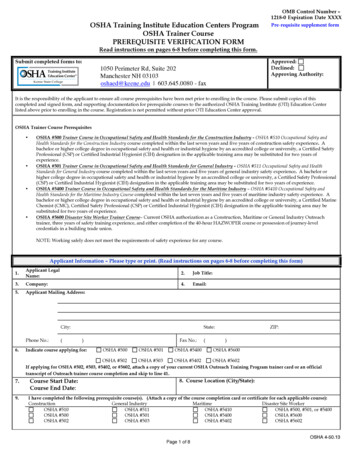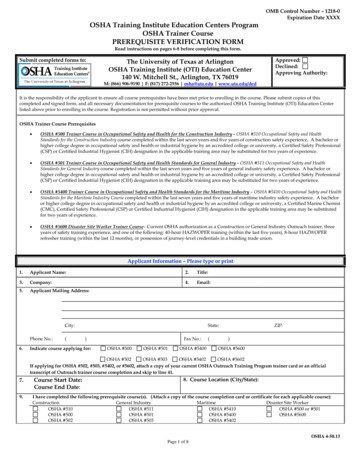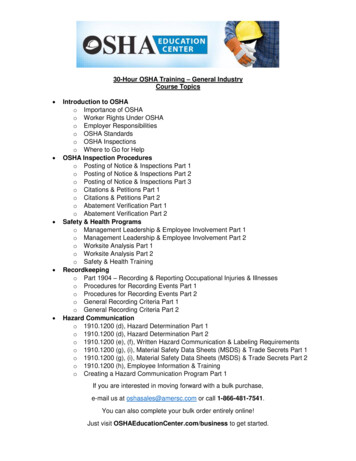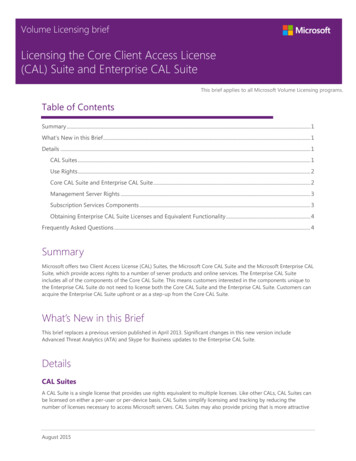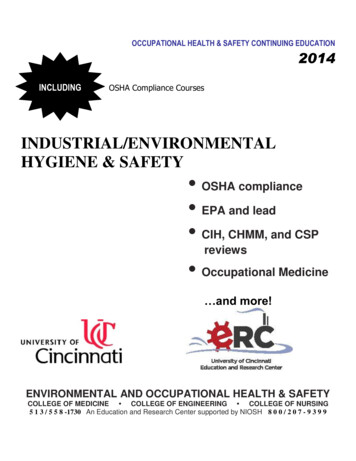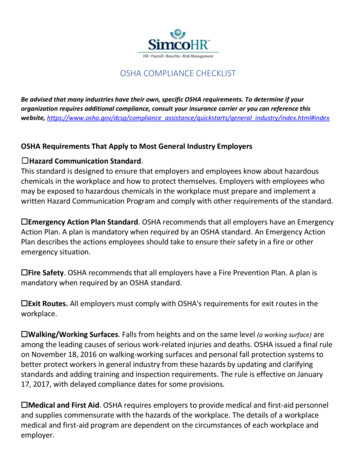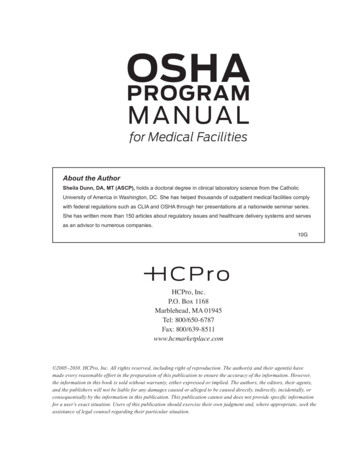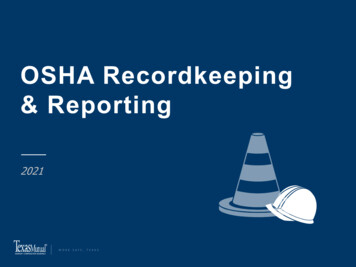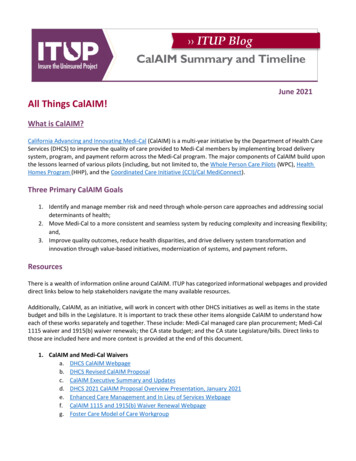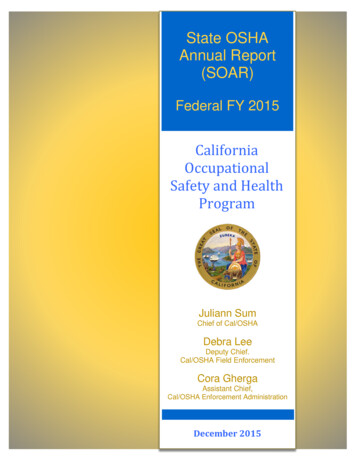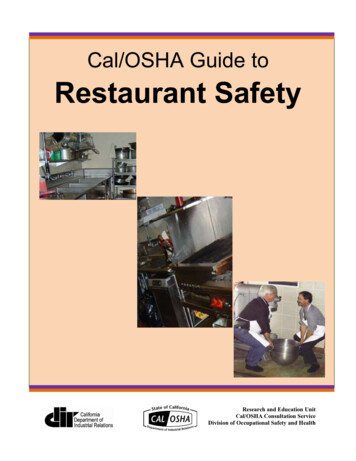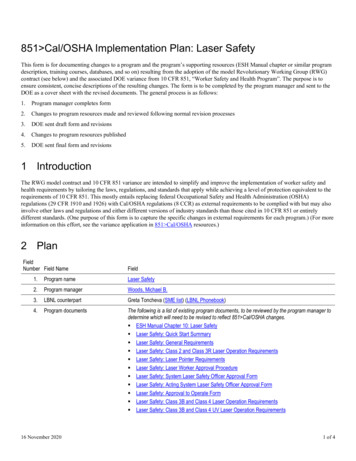
Transcription
851 Cal/OSHA Implementation Plan: Laser SafetyThis form is for documenting changes to a program and the program’s supporting resources (ESH Manual chapter or similar programdescription, training courses, databases, and so on) resulting from the adoption of the model Revolutionary Working Group (RWG)contract (see below) and the associated DOE variance from 10 CFR 851, “Worker Safety and Health Program”. The purpose is toensure consistent, concise descriptions of the resulting changes. The form is to be completed by the program manager and sent to theDOE as a cover sheet with the revised documents. The general process is as follows:1.Program manager completes form2.Changes to program resources made and reviewed following normal revision processes3.DOE sent draft form and revisions4.Changes to program resources published5.DOE sent final form and revisions1 IntroductionThe RWG model contract and 10 CFR 851 variance are intended to simplify and improve the implementation of worker safety andhealth requirements by tailoring the laws, regulations, and standards that apply while achieving a level of protection equivalent to therequirements of 10 CFR 851. This mostly entails replacing federal Occupational Safety and Health Administration (OSHA)regulations (29 CFR 1910 and 1926) with Cal/OSHA regulations (8 CCR) as external requirements to be complied with but may alsoinvolve other laws and regulations and either different versions of industry standards than those cited in 10 CFR 851 or entirelydifferent standards. (One purpose of this form is to capture the specific changes in external requirements for each program.) (For moreinformation on this effort, see the variance application in 851 Cal/OSHA resources.)2 PlanFieldNumber Field NameField1.Program nameLaser Safety2.Program managerWoods, Michael B.3.LBNL counterpartGreta Toncheva (SME list) (LBNL Phonebook)4.Program documentsThe following is a list of existing program documents, to be reviewed by the program manager todetermine which will need to be revised to reflect 851 Cal/OSHA changes. ESH Manual Chapter 10: Laser Safety Laser Safety: Quick Start Summary Laser Safety: General Requirements Laser Safety: Class 2 and Class 3R Laser Operation Requirements Laser Safety: Laser Pointer Requirements Laser Safety: Laser Worker Approval Procedure Laser Safety: System Laser Safety Officer Approval Form Laser Safety: Acting System Laser Safety Officer Approval Form Laser Safety: Approval to Operate Form Laser Safety: Class 3B and Class 4 Laser Operation Requirements Laser Safety: Class 3B and Class 4 UV Laser Operation Requirements16 November 20201 of 4
SLAC National Accelerator LaboratoryEnvironment, Safety & Health851 Cal/OSHA Implementation Plan: Laser SafetyFieldNumber Field NameField Laser Safety: Laser Controlled Area Requirements Laser Safety: Class 3B and Class 4 Laser CoHE Requirements Laser Safety: Core Laser Safety Practices/Requirements Laser Safety: Class 3B and Class 4 Laser Eyewear Protection Requirements Laser Safety: Laser Controlled Area Visitor Requirements Laser Safety: Student Requirements Laser Safety: Laser Service Subcontractor Work Planning and Control Procedure5.Training coursesThe following is a list of existing training courses, to be reviewed by the program manager todetermine which will need to be revised to reflect 851 Cal/OSHA changes.Course materials are available for review. ESH Course 130, Laser Safety for Supervisors (ESH Course 130) ESH Course 131, Laser Accidents and Lessons Learned (ESH Course 131) ESH Course 132, Laser Safety Basics (ESH Course 132) ESH Course 253, Laser Worker Safety Training (ESH Course 253) ESH Course 253ME, Laser Worker Baseline Medical Exam (ESH Course 253ME) ESH Course 253PRA, Laser Alignment Safety Practical (ESH Course 253PRA)6.Other program resourcesThe following is a list of existing program resources, to be reviewed by the program manager todetermine which will need to be revised to reflect 851 Cal/OSHA changes. Laser Worker Approval Laser Safety Tool Laser Safety Program Site (SharePoint) Laser Safety Committee Guidance for SLAC System Laser Safety Officers (SLAC-I-704-701-004-00) General Laser Laboratory Safety for SLAC QLOs and LCA Workers (SLAC-I-704-701-003-00)7.Current external requirementsThe following is a list of current external requirements for this program, as identified in theprogram documents above. American National Standards Institute (ANSI) Z136.1, "Safe Use of Lasers" (ANSI Z136.1) Title 21, Code of Federal Regulations, “Food and Drugs, Chapter 1, “Food and DrugAdministration, Department of Health and Human Services”, Subchapter J, “RadiologicalHealth”, Part 1040, “Performance Standards for Light-emitting Products”, Section 1040.10,“Laser Products” (21 CFR 1040.10) Title 21, Code of Federal Regulations, “Food and Drugs, Chapter 1, “Food and DrugAdministration, Department of Health and Human Services”, Subchapter J, “RadiologicalHealth”, Part 1040, “Performance Standards for Light-emitting Products”, Section 1040.11,“Specific Purpose Laser Products” (21 CFR 1040.11) Title 29, Code of Federal Regulations, “Labor”, Subtitle B, “Regulations Relating to Labor(Continued)”, Chapter 17, “Occupational Safety and Health Administration, Department ofLabor (Continued)”, Part 1910, “Occupational Safety and Health Standards”, Subpart J,“General Environmental Controls”, Section 1910.147, “The Control of Hazardous Energy(Lockout/Tagout)” (29 CFR 1910.147) Title 29, Code of Federal Regulations, “Labor”, Subtitle B, “Regulations Relating to Labor(Continued)”, Chapter 17, “Occupational Safety and Health Administration, Department ofLabor (Continued)”, Part 1910, “Occupational Safety and Health Standards”, Subpart O,“Machinery and Machine Guarding”, Section 1910.212, “General Requirements for All16 November 20202 of 4
SLAC National Accelerator LaboratoryEnvironment, Safety & Health851 Cal/OSHA Implementation Plan: Laser SafetyFieldNumber Field Name8.Proposed external requirements16 November 2020FieldMachines” (29 CFR 1910.212) Title 29, Code of Federal Regulations, “Labor”, Subtitle B, “Regulations Relating to Labor(Continued)”, Chapter 17, “Occupational Safety and Health Administration, Department ofLabor (Continued)”, Part 1926, “Safety and Health Regulations for Construction”, Subpart D,“Occupational Health and Environmental Controls”, Section 1926.54, “Nonionizing Radiation”(29 CFR 1926.54) On-The-Job (OJT) Training Requirements (200-2P-1)The following is a list of current external reference/guidance documents. Title 21, Code of Federal Regulations, “Food and Drugs, Chapter 1, “Food and DrugAdministration, Department of Health and Human Services”, Subchapter J, “RadiologicalHealth”, Part 1040, “Performance Standards for Light-emitting Products” (21 CFR 1040.10),Section 1040.11, “Specific Purpose Laser Products” (21 CFR 1040.11) American National Standards Institute (ANSI) Z136.8, “Safe Use of Lasers in Research,Development, or Testing” (ANSI Z136.8) National Fire Protection Association (NFPA) 115-2016 (or most recent version), “Standard forLaser Fire Protection” (NFPA 115) Stanford University, Department of Environmental Health and Safety. Laser SafetyList all the external requirements that will apply to this program. To determine, start by looking upexisting external requirements in 851 Cal/OSHA resources (variance, gap analysis, and contract)and finding replacements (for example a specific section in 29 CFR 1910 to a specific section in 8CCR or a current version of an industry standard).Where Cal/OSHA requirements are lessstringent than those of 10 CFR 851, check with Jeremy Sawyer on which to use. Enter “nochanges” if none. Federal Laser Product Performance Standard (FLPPS): Title 21, Code of FederalRegulations, “Food and Drugs, Chapter 1, “Food and Drug Administration, Department ofHealth and Human Services”, Subchapter J, “Radiological Health”, Part 1040, “PerformanceStandards for Light-emitting Products”, Section 1040.10, “Laser Products” (21 CFR 1040.10) Federal Laser Product Performance Standard (FLPPS): Title 21, Code of FederalRegulations, “Food and Drugs, Chapter 1, “Food and Drug Administration, Department ofHealth and Human Services”, Subchapter J, “Radiological Health”, Part 1040, “PerformanceStandards for Light-emitting Products”, Section 1040.11, “Specific Purpose Laser Products”(21 CFR 1040.11) Title 8, California Code of Regulations, “Industrial Relations”, Division 1, “Department ofIndustrial Relations”, Chapter 4, “Division of Industrial Safety”, Subchapter 4, “ConstructionSafety Orders”, Article 34, “Nonionizing Radiation”, Section 1801, “Nonionizing Radiation” (8CCR 1801) Title 8, California Code of Regulations, “Industrial Relations”, Division 1, “Department ofIndustrial Relations”, Chapter 4, “Division of Industrial Safety”, Subchapter 7, “GeneralIndustry Safety Orders”, Group 2, “Safe Practices and Personal Protection”, Article 7,“Miscellaneous Safe Practices”, Section 3314, “The Control of Hazardous Energy for theCleaning, Repairing, Servicing, Setting-Up, and Adjusting Operations of Prime Movers,Machinery and Equipment, including Lockout/Tagout” (8 CCR 3314) Title 8, California Code of Regulations, “Industrial Relations”, Division 1, “Department ofIndustrial Relations”, Chapter 4, “Division of Industrial Safety”, Subchapter 7, “GeneralIndustry Safety Orders”, Group 6, “Power Transmission Equipment, Prime Movers, Machinesand Machine Parts (8 CCR 3940–4086) Title 8, California Code of Regulations, “Industrial Relations”, Division 1, “Department ofIndustrial Relations”, Chapter 4, “Division of Industrial Safety”, Subchapter 7, “GeneralIndustry Safety Orders”, Group 8, “Points of Operation and Other Hazardous Parts of3 of 4
SLAC National Accelerator LaboratoryEnvironment, Safety & Health851 Cal/OSHA Implementation Plan: Laser SafetyFieldNumber Field Name9.Proposed substantive changes10. Additional proposed substantivechangesFieldMachinery” (8 CCR 4184–4647) American National Standards Institute (ANSI) Z136.1, “Safe Use of Lasers” (ANSI Z136.1)Describe (list) the substantive changes to be made in the program, based on the new externalrequirements. Enter “no changes” if none. No changesDescribe (list) the substantive changes to be made in the program, in addition to those based onthe new external requirements. For example, those due to stakeholder input, other reviews andaudits, operating experience. Enter “no changes” if none. transferring training course credit from another institution for ESH 253 and ESH 253PRAequivalency LST Phase 2 upgrades, including facility approval (replaces this Ch10 approval form) Laser use at events, demonstrations, and with general public, including minors Service subcontractor procedure update (refer to Ch55 site access requirement SSSPtemplate on SharePoint needs update) Requiring review by the Radiation Protection Department for laser operations over a certainintensity (1015 W/cm2 or 1013 W/cm2 under certain conditions) for ionizing radiation hazards11. Affected program documentsList program documents affected by the changes above. Enter “no changes” if none. ESH Manual Chapter 10: Laser Safety Laser Safety: Approval to Operate Form is no longer needed Laser Safety: General Requirements Laser Safety: Class 2 and Class 3R Laser Operation Requirements Laser Safety: Class 3B and Class 4 Laser Operation Requirements Laser Safety: Laser Service Subcontractor Work Planning and Control Procedure12. Affected training coursesList training courses affected by the changes above. Enter “no changes” if none. No changes13. Other affected program resourcesList: other program resources (DBs, SP sites, etc) affected by changes (PM to populate)List other program resources affected by the changes above. Enter “no changes” if none. SSSP template-example on laser SharePoint for laser service subcontractor work14. Comments/Questions/IssuesAdd any comments or questions regarding applicable requirements or changes.[ Add text ]15. Status16. Date completed16 November 2020Initial draft (proposed changes)12/12/2019 (rev 10/5/2020)Draft (for DOE review)10/23/2020Final (published changes)11/16/20204 of 4
This chapter was last reviewed for currency 11/17/2020.The next thorough review is due 11/17/2023.ENVIRONMENT, SAFETY & HEALTH DIVISIONChapter 10: Laser SafetyQuick Start SummaryProduct ID: 554 Revision ID: 2208 Date published: 16 November 2020 Date effective: 16 November 2020URL: references/laserQuickstart.pdf1 Who needs to know about these requirementsThe requirements of Laser Safety apply to workers who use low-power lasers, operate high-power lasers, oraccess labs where such lasers operate; their line management, supervisors, points of contact, and ESHcoordinators; project managers; laser facility program managers, system laser safety officers (SLSOs), andthe laser safety officer (LSO); and Occupational Health and Purchasing.2 WhyHigh-power lasers (Class 3B and Class 4) used at SLAC can damage the eye and burn skin and exposeworkers to electrical currents, explosions, and fires; toxic materials and laser-generated air contaminants;and collateral radiation, noise, and ultraviolet light. Low-power lasers can create a startle hazard andtemporary flash-blindness, after images, and glare responses.3 What do I need to know Lasers are classified (Class 1, Class 2, Class 3R, Class 3B, or Class 4) based on the level of accessibleradiation and the associated ability to cause injury to the eye or skin. For example, a Class 4 laser iscapable of causing greater injury than a Class 3B laser. Hazard controls are based on the class. Work involving Class 3B or Class 4 lasers requires qualified laser operators (QLOs) (or, for limitedwork, laser controlled area workers) under the supervision of approved SLSOs, in laser controlledareas (LCAs) with engineering and administrative controls developed by line management and theSLSO and approved by the LSO. Use of other classes of lasers, including laser pointers, must meet basic safety requirements.4 WhenThese requirements take effect 16 November 2020.5 Where do I find more informationSLAC Environment, Safety, and Health Manual (SLAC-I-720-0A29Z-001) Chapter 10, “Laser Safety”Or contact the program manager.16 November 2020SLAC-I-730-0A05L-001-R0041 of 1
ENVIRONMENT, SAFETY & HEALTH DIVISIONChapter 10Laser SafetyProduct ID: 12 Revision ID: 2207 Date published: 16 November 2020 Date effective: 16 November 2020URL: pdfs/ESHch10.pdf1 PurposeThe purpose of this program is to mitigate the hazards posed by optical lasers, which operate atwavelengths between 180 nm and 1 mm. High-power lasers (Class 3B and Class 4) are used at SLAC inresearch and accelerator operations. The primary hazard associated with their operation is potential eyedamage; other potential hazards include skin burns, electrical currents, explosions, fires, toxic material,laser-generated air contaminants, collateral radiation, noise, and ultraviolet light. Low-power lasers (Class2 and Class 3R) include laser pointers and alignment lasers; they are safe when used as intended, butrequire some controls. This program covers the setup and operation of high-power lasers, encompassingoperation approval of laser controlled areas (LCAs), approval of system laser safety officers (SLSOs)assigned to the LCAs, and approval for two classes of laser workers: qualified laser operators (QLOs) andlaser controlled area workers (LCA workers). It also covers the operation of low-power lasers.It applies to workers who use low-power lasers, operate high-power lasers, or may access facilities wheresuch lasers operate; their line management, supervisors, points of contact, project managers, and ESHcoordinators; and laser facility program managers, SLSOs, the laser safety officer (LSO), and RadiationProtection, Occupational Health, and Purchasing.2 Roles and ResponsibilitiesFunctional roles and general responsibilities for each are listed below. More detailed responsibilities andwhen they apply are provided in the procedures and requirements.The roles may be performed by one or more individuals and one individual may play more than one role,depending on the structure of the organizations involved. Responsibilities may be delegated.2.1 Worker Becomes acquainted with all potential laser hazards in his or her work area Learns and follows the requirements of this chapter and the laser safety policies, procedures, andhazard control methods appropriate for the class of laser being used Follows work planning and control requirements, including requesting or conducting pre-job briefingsas appropriate16 November 2020SLAC-I-720-0A29Z-001-R023.91 of 16
SLAC National Accelerator LaboratoryEnvironment, Safety & Health DivisionChapter 10: Laser Safety2.2 Qualified Laser OperatorClass 3B or 4 lasers may only be used in approved LCAs, by qualified laser operators (QLOs) (or lasercontrolled area workers, see Section 2.3). Is approved and authorized by the SLSO, the LSO, and his or her administrative supervisor. May onlywork in an LCA after being approved. Follows procedures and requirements in the general and lab-specific standard operating procedures(SOPs) and job safety analysis (JSA) for the work area, including wearing the appropriate personalprotective equipment (PPE) Stops work and seeks instruction from the SLSO when encountering a circumstance that appearsunsafe or is not clearly covered in an SOP or JSA document Notifies SLSO of new or increased laser hazards in the workplace Informs the SLSO if a laser safety control or procedure should be changed or improved In the event of a known or suspected accident involving a laser, disables the laser hazard, then followsSLAC’s incident response procedures, which include getting appropriate medical assistance andnotifying supervisors, including the SLSO and the LSOGenerally, a QLO may only work in the laser facility for which he or she was approved. However, a QLOmay enter a laser facility without becoming a QLO for that facility and perform short-term service work(including alignment), measurements, or experiments in Class 4 mode, subject to the following conditions: The visiting QLO, called a service QLO, must have approval from his or her administrative supervisorand the SLSO (or their designees) for the facility being visited. The visiting service QLO must be escorted by one of the facility’s QLOs/LCA workers. There must be a pre-job briefing between the service QLO and the escorting QLO/LCA workers forthe work to be performed.Unescorted work in Class 4 mode may only be done by the laser facility’s own QLOs.2.3 Laser Controlled Area WorkerLaser controlled area workers perform support work such as controls electronics, data acquisition, andaccelerator operations. To do so they receive limited approval to be allowed access to laser facilities. Theyhave the same responsibilities as QLOs but are not authorized to perform laser alignment work, and,depending on the facility, may be restricted from changing operation mode or opening shutters.LCA workers may enter and perform service work in laser facilities not their own subject to the sameconditions that apply to visiting QLOs (see Section 2.2).2.4 Affected WorkerAffected workers are personnel other than QLOs, LCA workers, laser service subcontractors, or the LSOwho may need to perform work in a facility that houses Class 3B or Class 4 lasers.16 November 2020SLAC-I-720-0A29Z-001-R023.92 of 16
SLAC National Accelerator LaboratoryEnvironment, Safety & Health DivisionChapter 10: Laser Safety Must receive appropriate training about laser hazard controls if relying on the transport shutters as amachine guard Must work outside the envelope of the laser safety system (LSS) components May request to apply lockout/tagout (LOTO) for his or her work2.5 System Laser Safety OfficerEach Class 3B or Class 4 laser facility will have a designated system laser safety officer (SLSO), to whomthe line management and supervision responsibilities for laser safety are assigned. Is designated by the laser facility program manager and approved by the LSO Is knowledgeable of SLAC’s laser safety policies and implements the required controls Is a QLO for the laser facility to which he or she is assigned Ensures adequate work planning and control for safe laser operations Ensures adequate safety controls of laser hazards for all personnel, including visitors and the generalpublic, before permitting the operation of a laser Is familiar with management walkaround (MWA) requirements and performs frequent walkarounds oflaser facilities under his or her authority Suspends the operation of a laser when there is inadequate control of laser hazards Together with administrative supervisors, approves QLOs, service QLOs, and LCA workers and holdsthem accountable for meeting laser safety requirements. SLSOs should minimize the number of QLOsapproved for a specific laser facility by taking advantage of the service QLO and LCA workerdesignations. For LCA workers, SLSOs should implement the following controls:–Limit their number to only those that are essential and may need unescorted laser facility access–Limit their scope of work, including limiting radio-frequency identification (RFID) authorizationfor the laser safety control panel–Conduct periodic refresher on-the-job training (OJT)–Conduct pre-job briefings prior to their laser work and determine if their work needs to besupervised by a regular QLO–Determine if any additional LCA or nominal hazard zone (NHZ) controls are needed toaccommodate their work–Avoid scheduling their work during Class 4 laser operations as much as practical, in particular iflaser alignment will be taking place Designates and qualifies at least one acting SLSO to perform SLSO functions when not available Prepares and submits for LSO approval a lab-specific SOP before permitting Class 3B or Class 4 laseroperations. The SLSO will also prepare and submit for LSO approval any additional JSAs that may berequired for laser operations not adequately described in the SOP. The SLSO will ensure that thesedocuments adequately describe the control of laser hazards in the laser facility and comply with SLACpolicy.16 November 2020SLAC-I-720-0A29Z-001-R023.93 of 16
SLAC National Accelerator LaboratoryEnvironment, Safety & Health DivisionChapter 10: Laser Safety Approves configuration control form (CCF) description and completion of work under the CCF anddetermines additional notifications Determines appropriate training requirements for laser workers and ensures that all are appropriatelytrained on the specific lasers they will operate, including appropriate site-specific and laser-specificOJT. The SLSO must conduct refresher OJT annually. In the event of a known or suspected accident involving a laser, disables the laser hazard, then followsSLAC’s incident response procedures, which include getting appropriate medical assistance andnotifying line management and the LSO Acts as equipment custodian for laser systems Maintains a current inventory of all lasers within his or her responsibility. The inventory will includethe classification, wavelength, power, manufacturer, model designation, and serial number or SLACproperty control number of the laser. Maintains laser safety documentation on his or her laser facility’s Laser Safety SharePoint, in the LaserSafety Tool, or in a laser safety binder at the laser facility. This documentation includes the SOP,JSAs, and CCFs and other laser safety documentation, such as interface control documents, OJTdocumentation, certification procedures, and laser inventory. Shares with the laser facility program manager and the ESH coordinator responsibility for reviewingand addressing non-laser safety issues when approving laser facilities2.6 Acting System Laser Safety Officer Is designated by the SLSO to perform SLSO functions when the SLSO is not available Meets all requirements for an SLSO, including being a QLO for the laser facility in question andcompleting all SLSO training2.7 ESH Coordinator Shares with the laser facility program manager and the SLSO responsibility for reviewing andaddressing non-laser safety issues when approving laser facilities Assists with the qualification and work planning and control processes for laser service subcontractors2.8 Administrative Supervisor / SLAC Point of ContactNoteSLAC employees report directly to their administrative supervisor, and non-employees report toa SLAC point of contact, as described in Chapter 1, “General Policy and Responsibilities”.Administrative supervisors and SLAC points of contact have line management responsibility fortheir assigned workers. Line management for laser work of assigned workers is matrixedbetween the administrative supervisor and the SLSO. Assigns appropriate ESH laser safety training courses for assigned workers using the SLAC TrainingAssessment (STA) Discusses with the SLSO shared supervisory responsibilities, covering laser work to be performed byhis or her assigned workers, required ESH laser safety training courses, and any required site-specificOJT16 November 2020SLAC-I-720-0A29Z-001-R023.94 of 16
SLAC National Accelerator LaboratoryEnvironment, Safety & Health DivisionChapter 10: Laser Safety Conducts periodic discussions about laser work with his assigned workers and the SLSO Has line management responsibility for the conduct of his assigned workers Together with the SLSO, holds QLOs and LCA workers accountable for meeting laser safetyrequirements2.9 Project Manager Coordinates the qualification and work planning and control processes for laser service subcontractors2.10 Laser Facility Program ManagerEach Class 3B or Class 4 laser facility must have a designated program manager, who has line managementresponsibility for the facility. Designates an SLSO for each Class 3B or Class 4 laser facility under his or her control Assigns line management responsibility for laser safety in the facility to the SLSO Periodically discusses the facility’s laser operations with the SLSO Shares with the SLSO and ESH coordinator responsibility for reviewing and addressing non-lasersafety issues when approving laser facility2.11 Radiation Protection Department Reviews for ionizing radiation hazards laser operations over a certain intensity (1015 W/cm2 or 1013W/cm2 under certain conditions)2.12 Purchasing Department Notifies the LSO before an order is placed for laser eyewear protection or for a Class 3B or Class 4laser2.13 Occupational Health Center Conducts laser medical eye examinations, ESH Course 253ME, Laser Worker Baseline Medical Exam(ESH Course 253ME), for all employees, students, and users before they use Class 3B or 4 lasers atSLAC For any injury or suspected injury, conducts a laser medical eye exam and arranges for anophthalmology exam if needed. For all reportable laser incidents, must meet with affected personnel even when there are no symptomsand inform them of the availability of laser eye exams Conducts additional tests for SLAC employees if results of the baseline examination indicate anabnormality. For non-employees, SLAC requests that home institutions perform the required medicaleye examination and send results to the SLAC Occupational Health Center for review.16 November 2020SLAC-I-720-0A29Z-001-R023.95 of 16
SLAC National Accelerator LaboratoryEnvironment, Safety & Health DivisionChapter 10: Laser Safety Follows SLAC’s incident response procedures and notifies the LSO immediately if an eye injury dueto a laser accident is reported, suspected, or confirmed2.14 Laser Safety Committee Advises the LSO on laser safety matters and recommends improvements; also provides oversight andperiodic review, as requested Provides expertise in forming laser safety policy Maintains an awareness of all applicable laser safety policies2.15 Laser Safety Program Manager / Laser Safety Officer Is assigned by the laboratory director Reports to the chief safety officer (CSO) and advises him or her on laser safety policies andrequirements Establishes and maintains adequate policies for the control of laser hazards that comply with applicablefederal regulations and accepted industry standards Approves–Operation of all Class 3B and Class 4 lasers–The lab-specific SOP and JSA required for operation of a Class 3B or Class 4 laser–CCFs in instances where an LSO inspection if required–All QLOs and LCA workers Determines when new laser facilities or major changes to a laser facility should be reviewed by theLaser Safety Committee Has authorization to stop any operation for which he or she perceives the laser safety to be inadequateand can be overruled only by the CSO or the laboratory director Has authorization to inspect and monitor all laser operations and enforce laser safety control of hazards Classifies or verifies classification of all laser systems Consults on laser hazard evaluation and controls and assists SLSOs in developing SOPs and JSAs Reviews wording on laser area warning signs and equipment labels Ensures that the general laser safety training is adequate and available to all workers operating Class3B and Class 4 lasers Performs an annual laser safety inspection of each Class 3B and Class 4 laser facility to review thefacility’s laser systems, laser hazard controls, and compliance with the safety requirements given in thelab-specific SOP and JSA. The LSO will write an inspection report and submit the results to the SLSO,laser facility program manager, and ESH coordinator. Performs a hazard analysis for possibility of a hazardous exposure for all reportable incidents, andinforms the Occupational Health Center of results16 November 2020SLAC-I-720-0A29Z-001-R023.96 of 16
SLAC National Accelerator LaboratoryEnvironment, Safety & Health DivisionChapter 1
Laser Safety: System Laser Safety Officer Approval Form Laser Safety: Acting System Laser Safety Officer Approval Form . ESH Course 253, Laser Worker Safety Training (ESH Course 253) . Laser Worker Baseline Medical Exam (ESH Course 253ME) ESH Course 253PRA, Laser Alignment Safety Practical (ESH Course 253PRA) .
